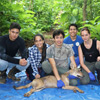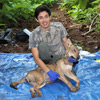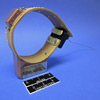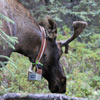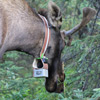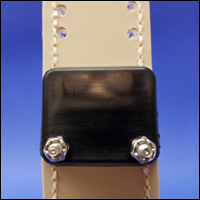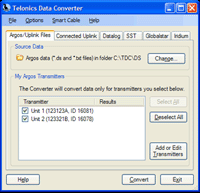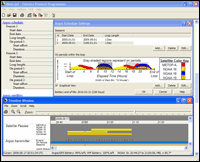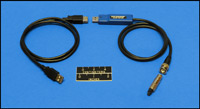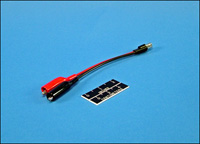GPS/Iridium Terrestrial Systems
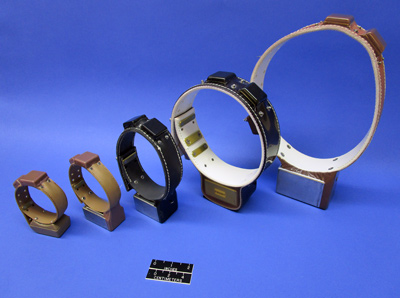
GPS/Iridium collars (TGW-4170-5, 4270-5, 4470-5, 4570-5, and 4670-5)
These collars collect GPS positions and transfer the positions and other data through the Iridium satellite system.
Telonics GPS/Iridium collars can be used to remotely obtain location and other data from terrestrial animals anywhere in the world. The collars can include mortality, activity, and temperature sensors; and/or geofencing technology. Users can define GPS, Iridium, VHF, and sensor schedules to best meet their project requirements. Iridium is a two-way system, which allows confirmation of messages received and remote modification of programmed parameters.
Telonics Quick Fix (QFP) can be incorporated into these collars. QFP is Telonics quick fix positioning technology that obtains the data necessary to calculate a GPS position in as little as about 2 seconds. This allows positions to be determined much more quickly and with less energy expenditure than a standard GPS position. Telonics Iridium units can be configured to collect GPS, QFP, or a mix of the two location types. Locations can all be transmitted, or some can be stored but not transmitted.
Models
- TGW-4*70-5 models are the basic GPS/Iridium series
- TGW-4*77-5 models allow for auxiliary schedules and geofencing
- TGW-4*79-5 models allow for auxiliary schedules, geofencing, and inclusion of Salt-water-switch technology
Examples of Operational Life
Operational life estimates shown below are calculated using Telonics Product Programmer (TPP), and are provided as examples only, with many other options possible. The estimates provided assume all GPS and/or QFP data is transmitted; battery life can be extended if some of the locations (GPS or QFP) are exclusively stored on board and not transmitted.
Please consult with Telonics for assistance determining what would work best for your application.
Models for Smaller, Down to Approximately Fox-sized, Mammals
| Model |
GPS Schedule |
Operational Life (years) |
| No VHF |
VHF
10 hr/week |
TGW-4170-5
TGW-4177-5 |
1/day |
4.5 |
3.2 |
| 4/day |
2.5 |
2.0 |
| 6/day |
1.9 |
1.6 |
| 12/day |
1.1 |
1.0 |
TGW-4270-5
TGW-4277-5 |
1/day |
6.5 |
4.7 |
| 4/day |
3.6 |
3.0 |
| 6/day |
2.8 |
2.4 |
| 12/day |
1.7 |
1.5 |
Operational life estimates for these small units assume temperatures of 10°C, VHF pulse period of 1500 msec (40 beats per minute), Iridium transmitting weekly (or more as required by data intensity). Average time to GPS fix is assumed to be 75 seconds. QFP can optionally be used to extend battery life.
Models for Medium to Large Mammals
| Model |
GPS Schedule |
Operational Life (years) |
| No VHF |
VHF
4 hr/day |
TGW-4470-5
TGW-4477-5 |
6/day |
4.4 |
3.3 |
| 12/day |
3.0 |
2.5 |
| 24/day |
1.9 |
1.6 |
| 48/day |
1.0 |
1.0 |
TGW-4570-5
TGW-4577-5
TGW-4579-5 |
6/day |
9.1 |
7.1 |
| 12/day |
6.4 |
5.3 |
| 24/day |
4.0 |
3.6 |
| 48/day |
2.3 |
2.1 |
TGW-4670-5
TGW-4677-5
TGW-4679-5 |
6/day |
10+ |
10+ |
| 12/day |
10+ |
9.9 |
| 24/day |
7.6 |
6.8 |
| 48/day |
4.5 |
4.2 |
TGW-4770-5
TGW-4777-5 |
6/day |
10+ |
10+ |
| 12/day |
10+ |
10+ |
| 24/day |
10+ |
9.5 |
| 48/day |
6.4 |
6.0 |
Operational life estimates for these units assume temperatures of 0°C, VHF pulse period of 1500 msec (40 beats per minute), and Iridium transmitting every other day. These units have GPS/Iridium/VHF all sharing a battery, and a separate smaller battery to provide additional VHF operation following the end of GPS/Iridium life to aid in collar recovery. Average time to GPS fix is assumed to be 75 seconds. QFP is typically not used in these larger configurations, though it can be.
Key Features
Features relative to use of Telonics transmitters operating through the Iridium system:
- The Iridium satellite network consists of 66 cross-linked satellites in low earth orbit (LEO), and provides continuous (24/7) coverage world-wide.
- Iridium is a two-way system. The Iridium module on the animal checks for an adequate link prior to data transmission, and data acknowledged as successfully received does not need to be repeated. The two-way link also allows commands to be sent to the Iridium unit while it is deployed on wildlife. Depending on what software and hardware options are selected, this can allow changing between auxiliary schedules, changing other programmed parameters, or remotely triggering a collar-release mechanism.
- With Telonics GPS units, a single Iridium message can contain up to 70-80 GPS positions, or about 10 QFP positions.
- Data is normally retrieved through a third-party data provider. Data rates depend on the amount of data transferred, but are frequently as low as about ~$7.50/unit/month with an Iridium transmission every other day. There is a one-time activation fee of $30 or $40 per transmitter.
- Telonics GPS Iridium units are FCC and IC certified and available for use throughout the United States and Canada with no additional licensing required for the data transfer component.
Other key features:
- In addition to the GPS and Iridium portions of these collars, they typically include a VHF transmitter. The VHF transmitters can be used to locate or monitor the animals from the ground or aircraft, and aid in recovery of a collar at the end of a study.
- The TGW-4270-5 and larger models are fully-hermetically sealed for maximum reliability, with the transmitter, battery, and interconnects sealed into a single metal housing. This is the same technology used by NASA for maintaining high performance electronics in harsh environments. With hermetic packaging, there is no problem with moisture penetration even after years of deployment, except in cases of severe physical damage to the canister. No polymeric packaging offers this level of reliability.
- Telonics CR-5 or CR-7 programmable collar release mechanisms can be added to collars of appropriate size (the CR-5 requires at least a 2-inch wide collar and the CR-7 requires at least a 1.5-inch wide collar). Iridium's two-way link allows remote triggering of either the CR-5 or CR-7 with certain models and when that option is selected at the time of order.
- Users can program or reprogram Telonics GPS/Iridium units through use of Telonics Product Programmer (TPP). TPP can be used to obtain estimates of battery life and data acquisition costs through metOcean telematics under various possible programming scenarios prior to deployment. TPP is also used to send commands to the Iridium unit once it is deployed if desired.
- GPS/QFP collection schedules, Iridium transmission schedules, VHF schedules, and sensor options can all be user-defined. Scheduling can be programmed to change over time (e.g. seasonal changes where monitoring might be more or less intensive at certain times of the year). Some Iridium units (TGW-4X77 series) allow the primary and up to three auxiliary schedules to be programmed, with easy switching between schedules controllable via TPP. TGW-4X77 models also allow users to reprogram the units remotely through Iridium and use of an authorized copy of TPP-GPS software.
- Transmissions can contain a mortality flag (which relates to whether there has been movement detected by an accelerometer within a user-defined period) and a low-voltage flag (which indicates the battery may die soon). Programming and accounts can be set up to receive real-time notification of mortality events via email.
- Activity or temperature data can be collected and transmitted via Iridium, and/or stored on board for downloading if the collar is recovered.
- Data retrieved through the Iridium system, or downloaded from a collar in hand, are processed using Telonics Data Converter (TDC). TDC is used to convert raw data from Telonics transmitters into data reports and to display locations on Google Earth and Google Maps. You can review, save, and edit TDC reports in Microsoft Excel or other spreadsheet programs.
- All positions determined and sensor data collected is stored-on-board the collar, thus if the collar is able to be recovered, stored data can supplement what was transmitted through Iridium.
- A real-time clock and calendar controls all timing functions and is re-synchronized with GPS time to assure high accuracy timing. All timing is programmed using Coordinated Universal Time (UTC).
- When turned off using a magnetic switch, these units consume less than 10 µA; this allows storage for extended periods with minimal impact on operational life.
- Units can be refurbished to their original condition at Telonics.
- Optionally delivers data to EarthRanger, allowing you to map historical and real-time locations online and create a unified view of data from Telonics collars and other sources.
- Optionally delivers data to Movebank, allowing you to map, manage, analyze, and optionally share your data with collaborators or the public.
Optional Geofencing - Show
Telonics TGW-4*77-5 and TGAV-4*77 series GPS/Iridium systems can support geofenced areas. Multiple geofence types are available to define areas of special interest, which may overlap:
- Rectangle - upper left and lower right coordinates are specified.
- Circle - center point and radius are specified.
- Polygon - Up to 50 points may be specified. Polygons may be concave or convex.
The following parameters can be separately defined when the unit is inside and outside the defined geofenced area:
- Acquisition schedule for GPS, QFP-GPS, and any included sensors (e.g. underwater, activity, and temperature)
- VHF Beacon schedule
- Iridium transmission interval, transmission retry delay, and message expiration
A geofence can be described as a virtual boundary around a physical geographical space, defined by a set of coordinates surrounding an area. Geofences may be established and maintained by a range of GPS-enabled devices including smartphones and devices designed for commercial applications like trucking and farming. Geofencing has also proven to be a useful tool for animal tracking studies.
Geofencing allows one or more geographical areas to be defined and provides customized data acquisition and transmission behavior based on whether the study subject is in "inside" or "outside" the geofence(s). A study subject is considered "inside" when inside any defined geofence, and is considered "outside" when outside all defined geofences.
The speed of detecting that an animal has crossed a geofenced boundary depends on how much time has elapsed between crossing the boundary and acquisition of the next GPS position. Therefore, the rate at which fix attempts are scheduled directly influences the time it will take the unit to detect boundary transitions. QFP-GPS data do not provide a resolved position until post processing has occurred, so QFP-GPS data cannot contribute to the detection of boundary transitions.
Optional Auxiliary Schedule Sets
With Telonics TGW-4*77-5 and TGAV-4*77 series GPS/Iridium systems, up to 3 Auxiliary schedule sets can be defined. Auxiliary schedules are useful for increasing or decreasing the intensity of data collection and/or data transmission. Auxiliary schedules are also useful for adjusting the VHF beacon duty cycle to save energy when there are no plans to be out in the field monitoring units with a VHF receiver. Auxiliary schedules can provide the following options to the primary schedule:
- Alternate schedules for collection of GPS, QFP-GPS, underwater, activity, and/or temperature data
- Alternate VHF Beacon transmission periods
- Alternate Iridium transmission interval, transmission retry delay, and message expiration
GPS/Iridium systems can be directed to execute an Auxiliary schedule (or return to the primary schedule) by sending commands over the Iridium data link.
Commands to GPS/Iridium systems are sent via email using Telonics Product Programmer (TPP). Internet connectivity and an email provider are required.
After receiving a schedule change command, GPS/Iridium systems will switch to the specified schedule immediately and will continue to execute that schedule until otherwise commanded. Sent commands are received by the fielded unit at the time of a scheduled Iridium transmission, or units can be programmed to check for messages more frequently by defining a "command check interval" which is shorter than the Iridium transmission interval.
Electronic Specifications
GPS/Iridium/VHF Specifications - Show
General Specifications
| Timing Accuracy |
Timing is synchronized to GPS time when available.
If the GPS time is not available, then internal timing accuracy is:
6 min/year at 25° C
30 min/year -20 to +40° C
47 min/year -40 to +70° C |
| Available Sensors |
Mortality, Activity, Temperature, Low Voltage (as allowed by specific software)
Salt-water-switch is a hardware and software option on some configurations. |
| Memory Capacity |
Capable of storing ~500K fixes in nonvolatile flash memory in association with other sensor data. |
| Programming |
Programmable using Telonics TPP software and TSC-9A cable. Programming options are hardware and software dependent, but include GPS, Iridium, and VHF schedules; sensor activation and schedules; and power output. |
GPS Receiver Specifications
| Performance |
-167 dBm tracking sensitivity
-148 dBm acquisition sensitivity |
| Datum |
WGS-84 |
| Time to First Fix (TTFF) |
30 seconds typical (with clear view of sky)
Quick Fix Pseudoranging (QFP) 2-5 seconds typical (with clear view of sky) |
Iridium Module Specifications
| General |
FCC ID Q639603N
Industry Canada ID 4629A-9603N
Frequency Range 1616-1626.5 MHz
Applicable FCC Rules CFR Title 47, parts 2, 15, and 25
Power Output 1.0 w (average) |
| Mechanical/Environmental |
Operating Temperature Range -40 to +60 °C |
VHF Transmitter Specifications (VHF is not implemented in all configurations)
OPERATION INTERLOCK: All elements of the VHF transmitter component are forced off whenever the Iridium transmitter module is on. This interlock device forcibly prevents simultaneous operation of the two transmitters, thus they are not considered to be co-located under FCC regulations.
| Available Frequency Options |
Option 700 138-175 MHz
Option 720 210-240 MHz
Note: Frequency can be programmed in 100Hz steps within a given frequency range. |
| Frequency Stability |
Better than ±3ppm at room temperature ±5 ppm total tolerance over full temperature range |
| Operating Temperature |
-40° to +70° C |
| Pulse Width |
Programmable (10 to 250 msec) |
| Pulse Period |
Programmable (265 to 5000 msec)
Multiple pulse periods selectable per specific software and TPP. |
| Transmitter Timing |
Programmable, including daily and seasonal duty cycles. |
| Power Output |
Selectable levels via hardware and software.
Effective Isotropic Radiated Power (EIRP) varies, depending on packaging, antenna configuration, and immediate environmental conditions. *California Users: This transmitter meets the California requirement of EIRP < 0.0009W for all configurations. |
| Emission Designator |
2k00P0N |
| Harmonic Suppression |
Better than 30dB (>40 dB typical) |
| Spurious Emissions |
<-35 dBc at 10 kHz offset from carrier |
| Frequency |
Aging: <2ppm/year
Shock: <1ppm 3000g x 0.3ms x ½ sine x 3 dir |
| VSWR |
RF output stable to 10:1 VSWR, all phases
Radiated harmonic levels are degraded with poor load VSWR.
Spurious emission specification maintained for >10:1 VSWR |
Notice to United States Users
This device complies with Part 15 of the FCC Rules. Operation is subject to the following two conditions: (1) this device may not cause harmful interference, and (2) this device must accept any interference received, including interference that may cause undesirable operation.
The user is cautioned that changes or modifications not expressly approved by Telonics could void the user's authority to operate the equipment.
This device contains FCC ID: Q639603N
To satisfy FCC RF Exposure requirements for mobile and base station transmission devices, a separation distance of 20cm or more should be maintained between the antenna of this device and persons during operation. To ensure compliance, operation at closer than this distance is not recommended.
Notice to Canadian Users
Under Industry Canada regulations, this radio transmitter may only operate using the antenna integrated into the device.
This device complies with Industry Canada license-exempt RSS standard(s). Operation is subject to the following two conditions: (1) this device may not cause interference, and (2) this device must accept any interference, including interference that may cause undesired operation of the device.
This device contains IC ID: 4629A-9603N
Photo Gallery
TGW-4*70-5 versions are shown, with TGW-4*77-5 versions similar with additional programming options. Various collar and casting options are shown, with such specifications user-definable at the time of order.
Manual
Related Products
Legacy Products
This information on discontinued products is provided for individuals who are still using these older systems. Product descriptions may be time sensitive or even outdated. Please contact Telonics if you have questions.
Telonics supports these products as possible based on availability of parts, software, or other considerations; but no longer sells them new.
Lithium Battery Shipping Regulations
Telonics Inc. ships all systems containing lithium batteries in accordance with the US Department of Transportation rules for hazardous materials set forth in 49CFR and the IATA Dangerous Goods Regulations.
Shipping dangerous goods can be complicated and confusing, consult a dangerous goods specialist if needed. The general requirements for shipping lithium batteries according to 49CFR are located in Part 173, Subpart 173.185 in the link below.
http://www.ecfr.gov/cgi-bin/text-idx?SID=e8334217c2c8d081457a5156872ad037&tpl=/ecfrbrowse/Title49/49cfrv2_02.tpl#0
Service Commitment
Since 1970, Telonics has built a reputation based on product quality, product support, service, and customer satisfaction. Telonics strives to produce the highest quality products, and to support those products accordingly.
Because of extreme conditions and the unpredictable nature associated with most telemetry applications, problems occasionally arise. Most problems can be resolved quickly. In all cases, we hope to be able to work in partnership with users to resolve problems to the user's satisfaction and to uphold our demonstrated commitment to excellence. If problems should arise, all products must be returned to our factory for failure analysis.
Warranty: GEN 4 GPS Systems - Show
Telonics warrants its GPS products to be free from defects in material and workmanship for a period of one year from the date acquired. Telonics does not warrant batteries.
Telonics designs and manufactures systems for a variety of applications using several satellite systems (GPS, Argos, Iridium, and Globalstar). At the time of manufacturing, Telonics equipment is tested to verify compatibility with the applicable satellite system(s). Telonics does not warranty equipment against changes in satellite system specifications or satellite operation after the date your equipment was manufactured. Unforeseeable or unplanned system changes would include, but are not limited to, elevated ambient noise levels in the radio frequency bands used for satellite communications, elimination of service in a region of the world, data outages due to technical problems within the satellite system network, or reductions in data transfer capability due to alterations in the constellation as a result of premature space vehicle failures or failure to replace space vehicles in a timely manner.
If a defect occurs, return the equipment to us within the proper time frame at the following address: TELONICS, 932 E. IMPALA AVENUE, MESA AZ USA 85204-6699. The customer shall arrange for and pay all shipping, insurance and related charges incurred in the shipment to and from Telonics under this warranty. Damage to any equipment resulting from misuse, accidents, unauthorized service, extreme conditions, or other causes, is excluded from this warranty. Telonics does not assume responsibility for loss or damage to equipment during shipment. Telonics does not assume responsibility for delays resulting from shipment on commercial or private carriers. We insure all equipment shipped from our facility and suggest that shipments to Telonics also be insured.
Upon the timely return to our facility, if defective, the product will be replaced or repaired at our discretion at no cost to the customer. This remedy is the exclusive remedy. This product is supplied without any further warranties or conditions, expressed or implied, including warranties of merchantability, quality or fitness for particular reason or those arising by laws, statutes or trade usage or course of dealing.
The entire risk, as to the results and performance of the product, is assumed by the customer. Neither Telonics, nor its suppliers, shall have any liability to the customer or any other person or entity for any indirect, incidental, special, or consequential damage whatsoever, regardless whether Telonics has been told of the possibility of such damages or that such damages might be foreseeable. Telonics has no responsibility or liability for the claims of any third party. The maximum aggregate to the customer, of Telonics and its suppliers, shall not exceed the amount paid by the customer for the product.





